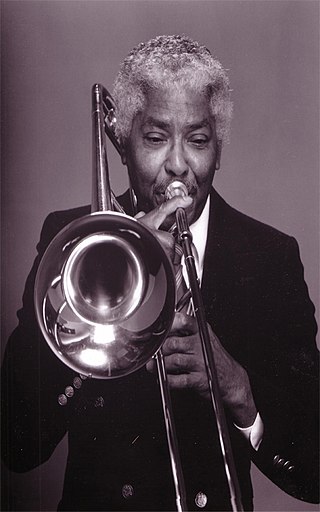Related Research Articles
Jerome Richardson was an American jazz musician and woodwind player. He is cited as playing one of the earliest jazz flute recordings with his work on the 1949 Quincy Jones arranged song "Kingfish".

Soul jazz or funky jazz is a subgenre of jazz that incorporates strong influences from hard bop, blues, soul, gospel and rhythm and blues. Soul jazz is often characterized by organ trios featuring the Hammond organ and small combos including saxophone, brass instruments, electric guitar, bass, drums, piano, vocals and electric organ. Its origins were in the 1950s and early 1960s, with its heyday with popular audiences preceding the rise of jazz fusion in the late 1960s and 1970s. Prominent names in fusion ranged from bop pianists including Bobby Timmons and Junior Mance to a wide range of organists, saxophonists, pianists, drummers and electric guitarists including Jack McDuff, Eddie "Lockjaw" Davis, and Grant Green.

Melbourne Robert Cranshaw was an American jazz bassist. His career spanned the heyday of Blue Note Records to his later involvement with the Musicians Union. He is perhaps best known for his long association with Sonny Rollins. Cranshaw performed in Rollins's working band on and off for over five decades, starting with a live appearance at the 1959 Playboy jazz festival in Chicago and on record with the 1962 album The Bridge.

Kenneth Earl Burrell is an American jazz guitarist known for his work on numerous top jazz labels: Prestige, Blue Note, Verve, CTI, Muse, and Concord. His collaborations with Jimmy Smith were notable, and produced the 1965 Billboard Top Twenty hit Verve album Organ Grinder Swing. He has cited jazz guitarists Charlie Christian, Oscar Moore, and Django Reinhardt as influences, along with blues guitarists T-Bone Walker and Muddy Waters.

Thaddeus Joseph Jones was an American jazz trumpeter, composer and bandleader who has been called "one of the all-time greatest jazz trumpet soloists".

Urban Clifford "Urbie" Green was an American jazz trombonist who toured with Woody Herman, Gene Krupa, Jan Savitt, and Frankie Carle. He played on over 250 recordings and released more than two dozen albums as a soloist. He was inducted into the Alabama Jazz Hall of Fame in 1995.

George Edward Coleman is an American jazz saxophonist known for his work with Miles Davis and Herbie Hancock in the 1960s. In 2015, he was named an NEA Jazz Master.
Joseph Dwight Newman was an American jazz trumpeter, composer, and educator, best known as a musician who worked with Count Basie during two periods.

Edwin Thomas "Ed" Shaughnessy was a swing music and jazz drummer long associated with Doc Severinsen and a member of The Tonight Show Band on The Tonight Show Starring Johnny Carson.

Shirley Scott was an American jazz organist. Her music was noted for its mixture of bebop, blues, and gospel elements. She was known by the nickname "Queen of the Organ".
Ernest Andrew Royal was a jazz trumpeter. His older brother was clarinetist and alto saxophonist Marshal Royal, with whom he appears on the classic Ray Charles big band recording The Genius of Ray Charles (1959).
Bernie Glow was an American trumpet player who specialized in jazz and commercial lead trumpet from the 1940s to 1970s.

James Milton Cleveland was an American jazz trombonist born in Wartrace, Tennessee.
Wayne Andre was an American jazz trombonist, best known for his work as a session musician.

Granville William "Mickey" Roker was an American jazz drummer.

Joseph Barry Galbraith was an American jazz guitarist.
Jack Nimitz was an American jazz baritone saxophonist, nicknamed "The Admiral".

Woody Herman–1963 is a 1963 studio album by Woody Herman and his big band. The album peaked at 136 on the Billboard 200.
This is the discography for American double bassist Ron Carter.
References
- ↑ JazzStandards.com. Retrieved 9 August 2013.
- ↑ Feather, Leonard (September 28, 1961). "The Blindfold Test: Horace Silver". DownBeat . Vol. 28, no. 20. p. 45.
- ↑ Koransky, Jason (March 2004). "The Songs Are My Life". DownBeat . 71 (3): 36.
- ↑ Bogdanov, Vladimir et al (2002) All Music Guide to Jazz: The Definitive Guide to Jazz Music, p. 587. Backbeat Books. At Google Books. Retrieved 9 August 2013.